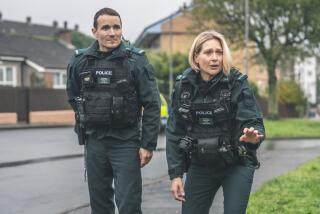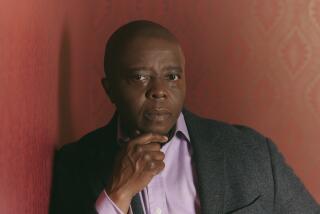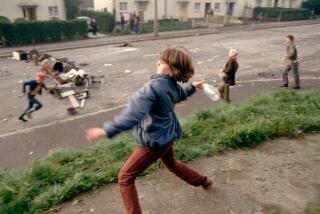Police Walk a Fine Line in Belfast
BELFAST, Northern Ireland — On May 4, 1973, a sniper shot Constable Jim Seymour in the head as he opened the gate to a fortified police station. For more than two decades, he lay paralyzed in a coma, a painful symbol in a long line of police casualties from this land’s sectarian warfare.
There may never have been a more dangerous place to be a cop than the gritty streets of Belfast. Across 25 bloody years, officers of the Royal Ulster Constabulary were murdered at an average of one a month. They were not incidental victims of crime but carefully chosen targets of terrorist assassins who stalked them on the job and at home.
“We can’t tell people what work we do. We can’t even hang our uniform shirts on the line to dry. It’s frustrating because we’re proud of what we do,” said Constable Darryl Flanagan, on patrol on Friendly Street in a tough Roman Catholic neighborhood.
Two years ago, a police officer died on Friendly Street when an Irish Republican Army rocket-propelled grenade destroyed his armored police van. Today, there are still tensions galore but there has been no cross-community bloodshed in Northern Ireland for almost 19 months.
The IRA broke a cease-fire in London with a Feb. 9 bombing and has refused all appeals to reinstate it. But there seems little will on either side for a return to violence in Northern Ireland itself. “We don’t have rose-tinted glasses on, but the cease-fire hasn’t been broken here and we are carefully avoiding any knee-jerk reactions for a return to a war footing,” said Dave Hanna, chief police spokesman.
Crouched in a fragile nether world between war and real peace, a controversial, terrorist-hardened police force is examining its own identity--and its future. “We used to hunt in packs. Now we are learning the art of normal policing, which is communication with the public,” said Precinct Cmdr. Adrian R. Robinson.
But how does a force weaned on war reinvent itself to serve a society thirsty for peace? How do men and women, as much soldiers as cops, adapt to routine police work? How does a postwar community relate to an image-tarnished force that has symbolized, some say exacerbated, the gap between majority Protestants and minority Catholics?
Some answers are evolving day by day on the streets. Others are arriving in packages. The Royal Ulster Constabulary is studying proposals for transformation to “peacetime policing.” The British government also is preparing a white paper to outline structural reform of the force.
Neither is apt to find favor with Sinn Fein, political arm of the IRA: It wants the royal constabulary disbanded. Nor will calls for change be likely to engage protective Protestant politicians or a union of police officers that warns it will reject any proposals that go beyond “evolutionary changes to meet the needs of the peace.”
In the flux of a terrorist stand-down that could presage lasting peace but could also collapse into renewed killing, the royal constabulary’s role remains much as it was during “the troubles,” said Belfast Police Cmdr. Bill Stewart.
“Our job is to hold the ground until there is a political solution. So far the transition has gone more smoothly than anticipated. We thought it might prove tougher to acclimatize to normal policing.”
Yesterday, Belfast cops wore body armor and carried long guns to combat sectarian killers. Since the bombings in London started, some officers are back in flak jackets, but they typically carry a regulation American-made .38-caliber pistol.
Yesterday, roadblocks, traffic stops and random searches punctuated by gunfire and bombs convulsed Belfast. Today, born-again traffic cops drive fancy unmarked sedans to trap speeders.
From 1969 until the Sept. 1, 1994, cease-fire, the royal constabulary, heavily reinforced by the British army, held the ground at the cost of 297 dead and 7,600 injured. In 1983, Interpol found Northern Ireland was twice as deadly for police as second-place El Salvador, then aflame in civil war.
In all, nearly 3,200 people died--including 652 British soldiers--and 37,000 were wounded in terrorist violence, some in English cities.
In Northern Ireland, population 1.5 million, police counted 35,000 shootings and 15,000 explosions. The royal constabulary says it seized 11,000 firearms and 246,400 pounds of explosives.
Police patrols, Belfast-style, are by now legendary: When rocket-propelled grenades made a single armored Land Rover too vulnerable, a second vehicle was added, McConnell recalls. When terrorists began to spray the first vehicle with gunfire and aim their grenades at the second, police added a third vehicle full of soldiers, two of them standing, weapons ready, through a cut-out section of the roof.
“The terrorists’ main goal was to kill police and soldiers,” said McConnell. “Everything you did was in the context of potential terrorist involvement, and every call could mean an ambush. We responded accompanied by soldiers, with more soldiers as backup and more police on periphery patrol as safeguard against ambush. It was frustrating, but we had to wait at the risk of getting somebody killed.”
Then, it could take police more than 20 minutes to double-check that a call was genuine and to roll the necessary response forces. Today, some soldiers have returned to Belfast since bombs began exploding in London, but they patrol only security areas. Police response time in Belfast is about four minutes.
Forged by fire, the royal constabulary became “the most skilled antiterrorist and innovative police force in the world,” said author Chris Ryder. Even in the worst days, the constabulary could pick the cream of the crop: It was then, and is now, swamped by applicants.
Overall, says Belfast chief of detectives Derek Martindale, terrorism at its peak was responsible for 8% of the crime in Belfast but demanded 70% to 80% of police resources to confront it.
Subtract terrorism, and by the standards of any big American city, the 850,000 residents of Greater Belfast are remarkably law-abiding. Streets are safe, violent crimes are rare, the drugs used are mostly pills and marijuana.
There were 53 murders in the eight months of 1994 before the cease-fire. In 1995, the first year in a quarter-century without terrorism, there were 11 murders in Belfast, seven committed by terrorists against members of their own communities; the other four were the result of what Martindale calls “ordinary decent crime.”
Crime has grown as a function of the relaxed security and because people are reporting things they once kept to themselves. “We had 25 domestic violence calls in one weekend. Before, they would never have come to our notice. The woman would have taken herself off to the hospital, and that would have been the end of it,” said Robinson, whose precinct is in the Shankill Road neighborhood, a stronghold of Protestant terrorists.
Urging more retraining for officers used to wartime policing, Robinson foresees strategic changes to take advantage of changing times. “We have to give the community confidence in the police to deal with crimes down to vandalism and graffiti,” he said. “If we don’t, they’ll go to the paramilitaries. We risk being usurped by vigilantes.”
Despite the cease-fire, Protestant and Catholic terrorist groups are intact, Stewart says. They continue recruiting and training, and they routinely inflict “punishment beatings” on petty criminals in their own areas to assert their authority.
In Catholic areas like the downtown Markets neighborhood, to call the police or to be seen talking to an officer once invited an intimidating visit from the neighborhood IRA.
“Nobody has suffered more than the people living in ghettos. They are afraid, but they are crying out for police service,” said Stewart. During the violence, police seldom heard sex-abuse complaints. In one recent case, though, a Sinn Fein member’s wife complained that an uncle was abusing a child.
Stephen Jones, who commands a community-policing unit in the Markets, says: “We’re asked to look into things like vandalism by people who would never have called us before. They’re more confident to talk with us; they even stop and pass the time of day. We think trust is being built up.”
Like all institutions in the six predominantly Protestant counties that remained under British authority when the rest of Ireland became a republic in 1922, the royal constabulary is a hostage of history.
It is a magnet for both sides in the struggle between majority Protestants who want Northern Ireland to remain in union with Britain and Catholic republicans who want the island reunited. The Protestant-Catholic ratio is about 60-40 in Northern Ireland.
Republicans see the constabulary, its membership 91% Protestant, as the armed fist of British repression. Sinn Fein spokesman Richard McAuley describes it as “a sectarian, paramilitary, political force which has from its inception sought to defend the unionist status quo.”
In the Sinn Fein view, the royal constabulary is rejected by the Catholic community and ought to be replaced “by a new, unarmed police service which can attract the support and allegiance of all sections of the people,” McAuley said in an interview.
This absolutist line is rejected totally by Protestants and does not persuade all Catholics.
“The IRA of course wants the [royal constabulary] disbanded because they want to be policemen. We have seen their brand of justice, and it is with the gun or the baseball bat, or through the exile of young people from Ireland. That is not what we want,” said Msgr. Dennis Faul, a moderate Catholic priest with an interest in policing.
Wedged between those who think that nothing needs to be done to the force because it is so good and those who say that nothing can be done because it is so bad lies a majority third school, says John D. Brewer, a sociologist at Queen’s University in Belfast.
“The consensus is that there must be changes in resources, manpower and mind-set. I think there are two key challenges: One is to win trust in the Catholic community, the other is to shift from a public-order police force to one that deals with less exciting kinds of crime,” Brewer said.
The very name of the force, both the “Royal” and the “Ulster,” annoys many republican Catholics. The size of the royal constabulary, about 13,000, will become problematic if peace lasts. There are about 10,500 unarmed police in the Irish Republic, which has more than twice Northern Ireland’s population.
“We need to redress the religious balance, but it is difficult because young Catholics are intimidated against joining and become isolated from their families once they do,” said Stewart. A harbinger of change: In the last royal constabulary graduating class, 20% of the new officers were Catholic, 35% were women.
As long as renewed killing does not come, greater resources can be earmarked for areas that get low priority during violence, such as drug prevention and traffic enforcement. Community, cop-on-the-beat, policing is also growing--too fast for some critics, and not fast enough for others, including some senior officers.
For a force in the middle, catching heat from both sides comes with the badge, says longtime street cop McConnell. “People will tell you the RUC this and the RUC that, but if it hadn’t been for this force, the toll would have been much higher.”
The toll is in remission now as politicians wrangle, but even during the cease-fire the honor roll of slain officers has grown.
Constable Jim Seymour, whose last conscious act was to begin opening a gate on May 4, 1973, died on March 2, 1995.
Montalbano was recently on assignment in Belfast.
More to Read
Sign up for Essential California
The most important California stories and recommendations in your inbox every morning.
You may occasionally receive promotional content from the Los Angeles Times.










